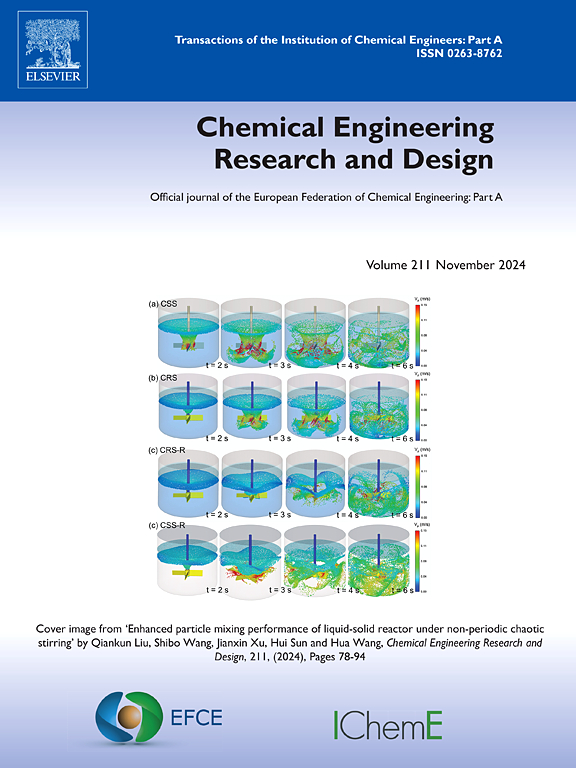Influence of external magnetic field on nanofluid dynamics using a two-phase Lattice Boltzmann Mixture Model at low Reynolds numbers
IF 3.7
3区 工程技术
Q2 ENGINEERING, CHEMICAL
引用次数: 0
Abstract
This work examines the behavior of an external magnetic field-induced Al2O3-water nanofluid flow between two parallel plates, with a particular emphasis on low Reynolds number scenarios. Understanding the dynamics of magnetohydrodynamic (MHD) flows in applications including energy systems, cooling systems, and medicinal devices depends on solving this problem. For the first time, a new two-phase lattice Boltzmann method was used to simulate the flow in conjunction with the mixture model. This methodology was specifically designed for nanofluid flow in the presence of magnetic field. Three coupled transport equations for flow velocity, concentration of nanoparticles, and magnetic field intensity are solved using this method. Three various cases were examined numerically. By comparing the simulated velocity profiles with analytical solutions in the first case, model validation was accomplished, demonstrating a strong agreement with less than 1 % variance. The impact of different inflow nanoparticle volume fractions (0.05 and 0.01) on the velocity field at various Reynolds numbers (0.5, 1, 10) and Hartmann numbers (0, 10, 20) was investigated in the second case. The findings showed that for Reynolds numbers of 0.5, 1, and 10, respectively, the velocity magnitude dramatically fell by approximately 75 %, 68 %, and 30 % as the Hartmann number grew from 0 to 20. Alongside this decrease, vortices began to form at Hartmann numbers of 10 and 20. Furthermore, the influence of the magnetic field diminished as the Reynolds number increased from 0.5 to 10, resulting in a noticeable reduction in vortex intensity. In the third case, where the nanoparticle volume fractions at the inlet were closer (e.g., 0.03 and 0.02), the intensity of the vortices decreased compared to the second case. The study demonstrates the robustness of the proposed model and its applicability across scientific and engineering domains. The novelty lies in quantifying MHD effects on nanofluid flow and particle distribution using a two-phase lattice Boltzmann approach, offering more precise and efficient simulations than existing methods. The findings provide new insights into the interaction between magnetic fields and nanofluids, especially at low Reynolds numbers, and emphasize the critical role of nanoparticle distribution in flow dynamics.
利用低雷诺数下的两相晶格玻尔兹曼混合物模型研究外部磁场对纳米流体动力学的影响
这项研究探讨了外部磁场诱导的 Al2O3-水纳米流体在两个平行板之间流动的行为,尤其侧重于低雷诺数情况。要了解能源系统、冷却系统和医疗设备等应用中的磁流体动力学,就必须解决这个问题。该研究首次采用了一种新的两相晶格玻尔兹曼方法,结合混合物模型来模拟流动。该方法专门针对存在磁场的纳米流体流动而设计。使用该方法求解了流速、纳米粒子浓度和磁场强度的三个耦合传输方程。对三种不同情况进行了数值检验。通过比较第一种情况下的模拟速度曲线和分析解法,完成了模型验证,结果表明两者非常吻合,方差小于 1%。在第二种情况下,研究了不同流入纳米粒子体积分数(0.05 和 0.01)对不同雷诺数(0.5、1、10)和哈特曼数(0、10、20)下速度场的影响。研究结果表明,对于雷诺数分别为 0.5、1 和 10 的情况,当哈特曼数从 0 增至 20 时,速度幅值急剧下降了约 75%、68% 和 30%。在速度降低的同时,哈特曼数为 10 和 20 时开始形成涡旋。此外,当雷诺数从 0.5 增加到 10 时,磁场的影响减弱,导致涡旋强度明显降低。在第三种情况下,入口处的纳米粒子体积分数更接近(如 0.03 和 0.02),涡流强度比第二种情况有所降低。这项研究证明了所提模型的稳健性及其在科学和工程领域的适用性。新颖之处在于利用两相晶格玻尔兹曼方法量化了 MHD 对纳米流体流动和粒子分布的影响,提供了比现有方法更精确、更高效的模拟。研究结果为磁场与纳米流体之间的相互作用(尤其是在低雷诺数条件下)提供了新的见解,并强调了纳米粒子分布在流动动力学中的关键作用。
本文章由计算机程序翻译,如有差异,请以英文原文为准。
求助全文
约1分钟内获得全文
求助全文
来源期刊

Chemical Engineering Research & Design
工程技术-工程:化工
CiteScore
6.10
自引率
7.70%
发文量
623
审稿时长
42 days
期刊介绍:
ChERD aims to be the principal international journal for publication of high quality, original papers in chemical engineering.
Papers showing how research results can be used in chemical engineering design, and accounts of experimental or theoretical research work bringing new perspectives to established principles, highlighting unsolved problems or indicating directions for future research, are particularly welcome. Contributions that deal with new developments in plant or processes and that can be given quantitative expression are encouraged. The journal is especially interested in papers that extend the boundaries of traditional chemical engineering.
 求助内容:
求助内容: 应助结果提醒方式:
应助结果提醒方式:


